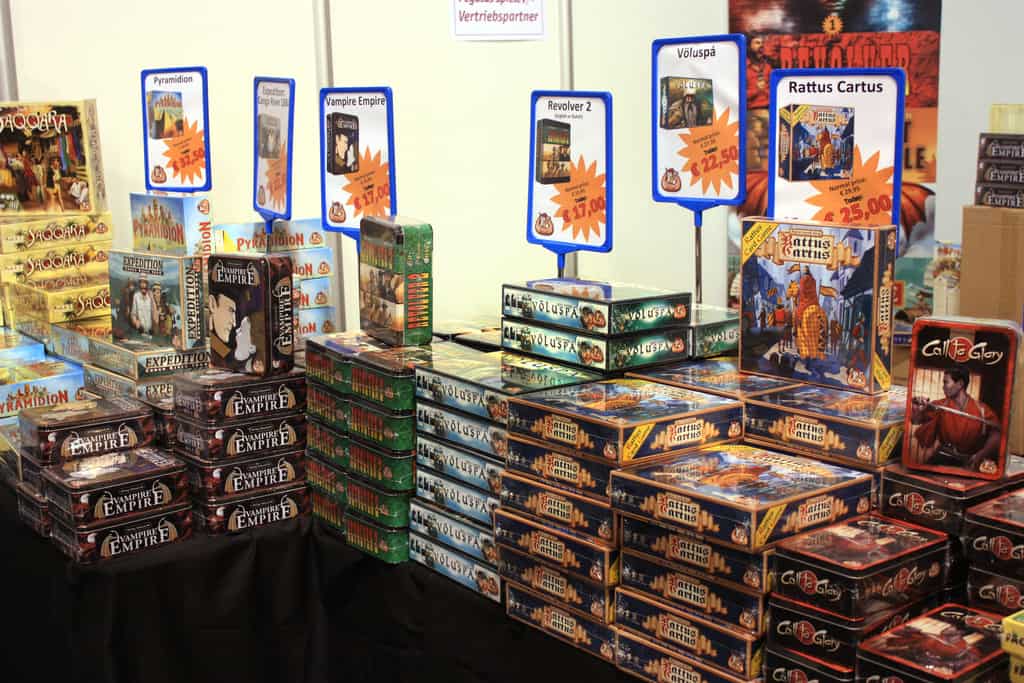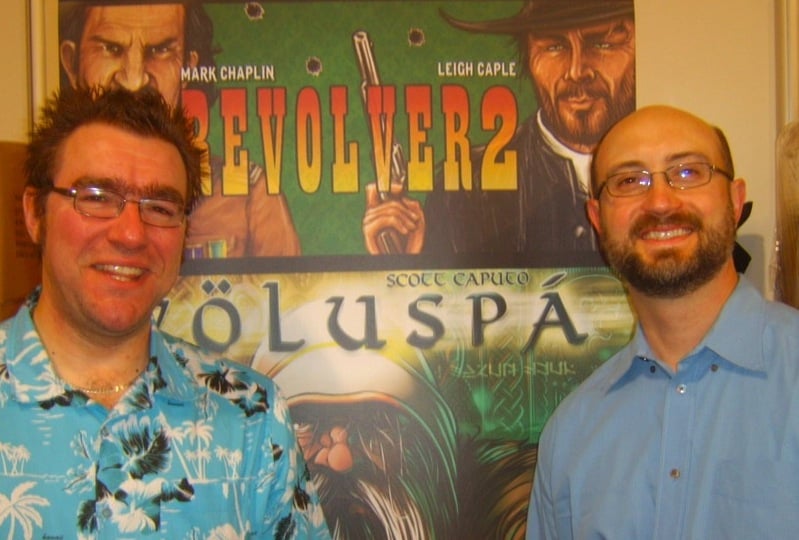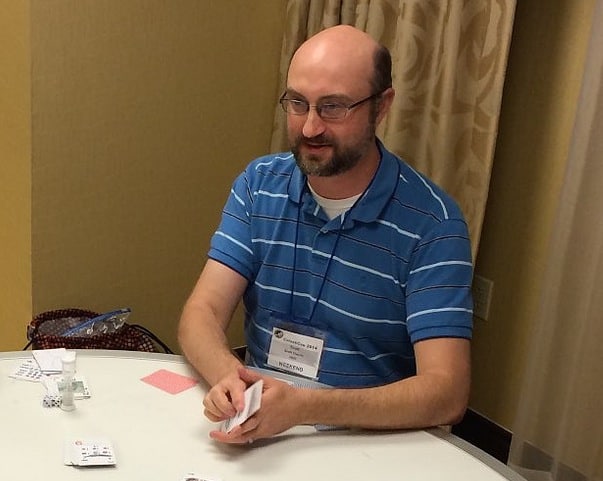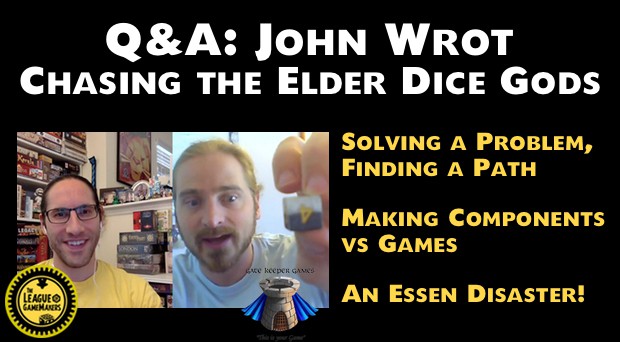
Guest Post by Scott Caputo, designer of the boardgames Kachina and Völuspá, and author of a book of poetry: “Holy Trinity of Chiles“
Introduction by Luke Laurie: I met Scott Caputo at the Celesticon game convention in September of 2014. Scott is a great designer and was a fabulous contributor to the first “Celestispiel“, where he playtested a few of his current prototypes including “Cheez” and “Ruthless Pirates”. It’s not every designer who can step into the big leagues at Essen, but Scott Caputo did. Below is his tale of triumph, defeat, tragedy, and success. Enjoy!
THE INVISIBLE THRESHOLD
After getting Kachina published in 2009 and Völuspá published in 2012, I thought maybe I had passed through some invisible threshold through which I would no longer struggle to get games published. Instead, I thought if I had a reasonably good idea and did a reasonable amount of play testing, I could get that game published.
I found out how wrong I was. I certainly have not passed through any threshold and I’m not sure such a threshold exists even for the best game designers.
EVERY GAME DESIGN IS A UNIQUE STRUGGLE
A DARING PLAN
With Völuspá being released at the Essen fair in October 2012, I had a master plan that I would go to the fair to promote my game and pitch an array of new games to publishers, hopefully starting an annual tradition.
I met Tom Lehmann at Meeplefest in the summer of 2012 before the Essen fair and he gave me a daring plan on how to meet up with publishers. Since White Goblin Games was publishing my game and I had a relationship with them, I should ask them for their contacts at other companies. Would White Goblin Games really do that? It was an awkward email for sure, but surprisingly they gave me great contacts at three companies on my list of publishers to meet: Kosmos, Argentum Verlag, and Lookout Games.
Tom stressed the importance of having an appointment to pitch games before Essen started. After several weeks of back and forth emails with the various companies, I secured appointments at all three companies plus a pitch session with White Goblin Games too. Things were certainly looking up.
Running up to the fair, I put countless hours into play testing my four new games: “Zamindar”, “Graveyard Wars”, “Cheez” and “Dot to Dot”. I went to conventions. I hosted game nights. I made revision after revision. I certainly felt ready and I thought my games were ready. Based on my limited experience from Kachina and Völuspá, my new games certainly seemed good enough to be published.

Mark Chaplin, designer of Revolver, and Scott Caputo at Essen 2012. Photo Credit: Mark Chaplin
ARRIVING AT ESSEN
I boarded the plane for Germany with two copies of each prototype and a crazy amount of anticipation. I remember bounding through the London airport to catch a connecting flight to Düsseldorf with my prototypes in my hand. On the opening day of the convention, I rushed in with the throngs of people excited to see the latest games. I felt like a real game designer. I had a game premiering at the show. I was signing box covers. I had appointments with companies to pitch games. I felt like I had arrived.
I FELT LIKE I HAD ARRIVED.
 Völuspá for sale at the White Goblin Games booth at Essen Spiel 2012. Photo Credit: Henk Rolleman
Völuspá for sale at the White Goblin Games booth at Essen Spiel 2012. Photo Credit: Henk Rolleman
PITCHING GAMES AT ESSEN
My pitch sessions with Argentum Verlag and Lookout Games were surprisingly relaxed affairs. Both times, I did my demo in the cafeteria over a cup of tea. Surprisingly, they wanted to play a whole game of “Zamindar”. Lookout Games took a prototype for further evaluation.
Kosmos was a different matter. When I approached the Kosmos booth, I had to check in with an assistant who looked for my name on a big appointment book. After a few minutes, I was ushered into a small room in the heart of the Kosmos booth. The white-walled room contained only a table and two chairs. I pitched my games to a woman named Barbara who listened politely, but would quickly declare: “there is something missing here.” I showed her all four games and each one she quickly found fault or would say something like “Reiner Knizia showed me a game like this already.” She was tough. She did not take any prototypes.
“REINER KNIZIA SHOWED ME A GAME LIKE THIS ALREADY”
Still, my appointment with White Goblin Games seemed to go great. I met up with them after hours at their hotel for drinks and we headed into the hotel meeting room full of gamers opening up shrink wrapped games. I showed White Goblin Games “Graveyard Wars” which had their entire team laughing and hollering. Their president asked for both copies of the game. Plus, he took two other games.
As the fair went along, I got bolder. I wandered into the Ravensburger booth on a lark to see if I could get an appointment. To my surprise, I did. A few days later, I pitched my games in another inner room, in the Ravensburger booth. This time, the Ravensburger man seemed impressed by my games and he ended up taking two prototypes.
By the end of the fair, I had placed all four games, and given away six of the eight prototypes. This was beyond any of my hopes and it seemed almost a sure bet that at least one of games would be picked up if not more!
 Photo Credit: Jeremy Commandeur
Photo Credit: Jeremy Commandeur
NO, NO, AND NO
The initial feedback from publishers seemed promising. Lookout Games reported how “Zamindar” was “in the finals” and was being brought to some big meeting at the Nuremburg where they played and discussed all prototypes. But one by one, the responses came back as “No”. First, Ravensburger and then Lookout Games. White Goblin was a different case altogether. I could never get a response out of them and after a year of waiting, I decided to withdraw my games. I’m sure they had their reasons, but it seemed like they were in no hurry to publish me again.
So, a year after my awesome Essen, of placing all those games, it all amounted to no new published games. It was disheartening to say the least. These games were good enough, right? After another round of pitching the same games at Origins in 2013 with the same results, I had to finally admit to myself that maybe these games weren’t as good as I thought they were. I kept hearing Barbara’s voice from Kosmos declaring: “There is something missing here…”
I had to let go of my master plans and other delusions of grandeur.
EMBRACING CHANGE
So, in the summer of 2013, I went back to work on my games. For “Zamindar” and “Dot to Dot”, I imagined what the expansion for those games would be like. I stole the best ideas from my expansions and incorporated them into the base game. This worked really well and both games opened up in new ways that really got me excited.
For “Graveyard Wars”, I had to really listen to everything people had been telling me about the game. Jesse Schell starts his book, The Art of Game Design, by saying the most important trait of a game designer is to listen and I really believe it. With all of these pitches, people had been telling me a LOT things about my games, some things positive, some things negative, and deep down I realized I agreed with most of the negative comments.
I remember sitting down with “Graveyard Wars” rules and deleting every rule that didn’t make sense or was difficult to explain. I totally reworked the combat system, a combat system that was maybe a little boring before, and attempted to transform it into something truly dramatic and memorable. To work on balance issues between different factions, I kept track of statistics of how often various factions won the game. I attacked changes I knew I needed to make, but never knew how to fix before. Maybe it was just being open to change, but solutions started to come my way and I embraced them.
 Photo Credit: Jeremy Commandeur
Photo Credit: Jeremy Commandeur
PROTOSPIEL SAN JOSE 2014
In May 2014, I attended ProtoSpiel San Jose with revised versions of my games. What happened next is still in process, but I signed a contract with one company for “Zamindar” (the final version will have a different name) and I seem really close to signing “Graveyard Wars” with a different company. That’s not to say I am not still making changes with these games and addressing concerns from publishers, but the conversations have changed. Instead of looking for reasons not to publish my games, these publishers seem to be saying “there is something here” and it’s a great thing to hear at last.

HAVE YOU BEEN TO ESSEN?
HAVE YOU FACED REJECTION OF YOUR GAME DESIGNS?
FEEL FREE TO SHARE YOUR THOUGHTS BELOW!









